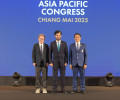Question: Are driverless vehicles a threat or an opportunity for design houses?
As the automotive industry looks increasingly to a future based on driverless vehicles, AUTO asks three of the greatest Italian car designers how this might affect creativity

GIORGETTO GIUGIARO: CAR DESIGNER OF THE 20th CENTURY; AUTOMOBILE HALL OF FAME MEMBER
I don’t believe that there is any essential difference in designing a conventional car and what we might do with autonomous vehicles. The aesthetic is fundamentally the same. This shape must be innovative; the functionality and the aesthetic must be matched. The car must be beautiful, even if the car drives itself.
In fact, I would say that autonomous cars present a great opportunity to designers. You have a huge advantage because the structure can be approached radically. Currently there are many elements of a car that you have to design around the driving position, so there are many restrictions. This new technology means that the design of autonomous cars is really open. We can put a lot more fantasy into the aesthetic.
When you drive a current vehicle there are some design restrictions on visibility for homologation, but that will not be an issue with autonomous vehicles, the structure of them will alter because the rules will change and that’s quite exciting. The one thing you cannot get away from, though, is that man does not change, our physique doesn’t change. We are maybe a little bit taller than we used to be, but you have to get in and get out of the car the same way – your feet have to go somewhere! So, in the end, the car will be made more around the person.
It will certainly promote more comfort. People will demand more comfortable environments and I think performance will be less of an issue. After all, what’s the meaning of having a sports car in a world of speed limits? You are simply an astronaut in the city. Ego demands that you love the car you drive but in the end you never use much of that car’s capability, so this demand may change in a car that you do not drive yourself.
It will change, but I think it will remain a beautiful object, regardless. People will always want beautiful things. We are thinking particularly that this kind of car will be more customisable, so people will be able to personalise their car more. So it may be that the big OEMs will produce a chassis that works and on that coach-builders will fashion something more personalised and bespoke. In some ways it may lead to a return to the old days of coach building.
LEONARDO FIORAVANTI: FAMED FERRARI DESIGNER; CEO, FIORAVANTI SRL
This question reflects an important reality: the car, thought for dead not a long time ago, is still today and for the future a lively topic of design and global manufacturing.
To specify better, it can be said that for some special conditions driverless vehicles will have certain uses, but not all.
As for any innovation, after a necessary period of tuning and tests, these types of vehicles will be able to ensure safety and comfort for the passengers; they will be able to not only enjoy the view better, but also carry out other activities during the trip.
But what kind of vehicle? I think mainly electric cars because of these characteristics: they can have various connection modalities, immediacy of response and input, and especially ease of accuracy in fine adjustments.
As regards the car bodies this type of guide offers, directly and indirectly, new opportunities for the doors-seats system and in general for the passenger compartment. Seats ‘vis a vis’ and semicircular offer a chance to stretch the legs and change position. The dashboard can be in very different configurations and there are unthinkable ways for optical and sound information.
For these reasons I consider the driverless vehicle a chance for creative minds that have both the fantasy and imagination.
These reflections also create an interesting connection. Do you remember that the first passenger transportation was the horse carriage? The passengers got into the carriage, gave the destination to the coachman and then chatted or… courted a beautiful woman.
Today we will have an electric motor and an electronic coachman! Back to the future.
PAOLO PININFARINA: PININFARINA DESIGN COMPANY MANAGER
Whatever form autonomous vehicles take, they will open up great opportunities for designers, who will be able to influence how they are made. Designers are continuously doing innovative research in the automobile sector, but also in other sectors – in technology, materials. These different experiences are valuable for designers and they can bring this contribution to new automobile technology.
It could be that autonomous vehicles represent a new product – perhaps a system rather than a single product, a people mover. In the same way you drive a train, a driverless car may not be piloted by a human being and may carry many people; it’s a service. This is the kind of opportunity that exists and we are open to providing ideas.
The advent of this kind of technology gives you great freedom. The space, the functionality – every aspect of it is a new challenge. It is one we are excited about, to the extent that recently we supported a design competition involving four design schools – the Italian IAAD, the international network IED, the French ISD Rubika and the Swedish UMEA – with each looking at the future of car design.
Also, car designers are not limited to the automotive sector. Indeed, I think Giugiaro started designing other products in the 1970s and Pininfarina did the same, and all of us made design about everything. So why not bring that creativity to the driverless car.
The driverless car will be an interesting sector. I believe it will arise in niche areas first; for example, for older people. The market among people who cannot drive a car any more because they don’t see well or their movement is restricted will open up. I believe that Japan will be one of the first markets for this type of vehicle because they have the highest number of wealthy people in old age.
So, for me, it will initially be another niche, as with zero emission or supercars, that develops gradually. I don’t see the autonomous car as antithetical to the traditional car. There will be hybrids. Much research is being done on assisted driving and the traditional car will increasingly feature assisted driving technology. So the border between traditional and autonomous cars will be blurred.
But for us, it is an exciting challenge. We are not frightened by change. Innovation is our inspiration and we have no fear.
This article comes from FIA Magazine Auto #16. You can read the full magazine here.

 Facebook
Facebook Twitter
Twitter






